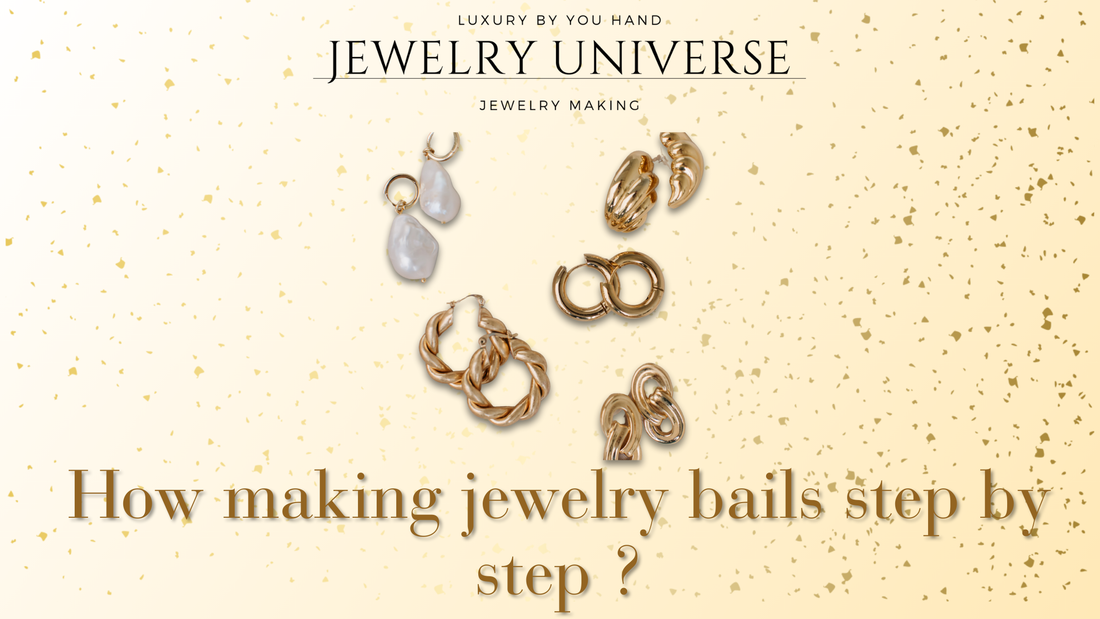
How making jewelry bails step by step ?
Share
Bails are essential components in jewelry making, serving as connectors between a pendant and a chain, cord, or wire. They provide both functionality and style, ensuring pendants hang securely and look polished.
Types of jewelry bails
Jewelry bails come in various shapes and sizes, including:
- Glue-on bails, which attach directly to the pendant.
- Pinch bails, that clasp onto the pendant with prongs.
- Snap-on bails, which can easily be added or removed from chains.
Choosing the right bail for your design
Material options
The choice of material for bails depends on the type of jewelry being created. Common materials include:
- Sterling silver for elegant, timeless designs.
- Gold-plated bails to complement warm-toned pieces.
- Stainless steel for durable and affordable options.
Matching bails to pendants
Selecting the right bail ensures the pendant’s balance and aesthetic appeal. Consider:
- The size of the pendant and its weight.
- The style of the chain or cord being used.
Tools and supplies for making bails
Essential tools
Creating bails requires a few fundamental tools:
- Pliers for bending and shaping.
- A jeweler's saw for precise cuts.
- Files for smoothing rough edges.
Optional tools for advanced designs
More intricate bail designs may need additional equipment, such as:
- Mandrels for forming consistent shapes.
- Rotary tools for engraving or adding details.
- Soldering kits for creating custom designs.
Crafting simple bails
Glue-on bails
These are among the easiest to create. A small dab of strong adhesive connects the bail to a flat-backed pendant.
Steps to make glue-on bails:
- Select a flat pendant with a smooth surface.
- Apply an even layer of jewelry glue.
- Attach the bail and allow it to dry thoroughly.
Wire-wrapped bails
For a handmade touch, wire-wrapped bails add charm and uniqueness to a piece.
Tips for wire-wrapping:
- Use softer metals like sterling silver or copper for easier manipulation.
- Twist and loop the wire to form secure connections.
Designing custom bails
Personalized shapes and styles
Custom bails allow artisans to incorporate unique designs, such as floral motifs, geometric patterns, or initials.
Adding embellishments
Enhance bails with decorative elements like gemstones, beads, or engraving. This adds aesthetic value and makes the jewelry stand out.
Techniques for advanced bail making
Soldering bails
Soldering involves heating metal components to join them permanently. This technique is ideal for creating robust, intricate bails.
Soldering essentials:
- A soldering torch.
- Heat-resistant surfaces.
- Safety gear like goggles and gloves.
Casting bails
Casting involves pouring molten metal into molds to create uniform, detailed bails. This technique is suitable for producing multiple pieces of the same design.
Troubleshooting common challenges
Achieving symmetry
Ensuring bails are symmetrical can be tricky, especially in hand-crafted designs. Using templates or mandrels can help maintain consistent shapes.
Ensuring strength and durability
Weak bails can result in lost pendants. Testing each piece for durability and reinforcing connections with strong adhesives or soldering is essential.
Marketing handmade bails
Selling to other jewelers
Artisan bails are in demand among jewelry makers. Offering unique, customizable designs can attract buyers.
Packaging and presentation
Displaying bails professionally, such as in labeled trays or elegant boxes, highlights their craftsmanship and increases their appeal.
Tips for beginners
Start with simple designs
Beginners should practice with basic bails like glue-on or pinch styles before advancing to more complex techniques.
Experiment with materials
Trying out different metals and finishes can inspire creativity and help discover a signature style.
Expanding your skillset
Attend workshops
Jewelry-making classes often include bail-making techniques and provide access to advanced tools.
Combine skills
Integrating bail-making with other jewelry-making methods, such as stone setting or wire wrapping, broadens artistic possibilities.
Creating jewelry bails is a rewarding skill that combines practicality with artistic expression. Whether designing for personal projects or crafting for sale, mastering the art of making bails enhances any jeweler’s repertoire.
